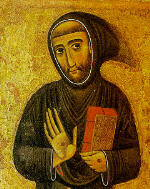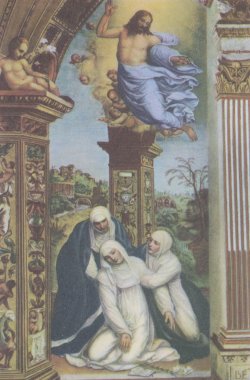 |
 |
Stigmata
|
|
Introduction to Stigmata:
Examples of Stigmata:
In all, there are around 321 generally accepted stigmata and 62 of these people have been beatified (sainted). There are no examples before the 13th century. Interestingly, there are only 41 examples of males experiencing stigmata. The suffering of the Stigmata is the most important aspect of this miracle. There are instances of "invisible stigmata," stigmata where there are no visible signs; all that is present is the suffering associated with stigmata. Stigmata represents a very real connection with the sufferings of Christ. Those who experience stigmata are those who have most fervently wanted it. They want to experience the sufferings of Christ so that they may associate with him and so that their sufferings will benefit others.
St. Francis of Assisi
 |
St. Francis was one of the first saints to receive the stigmata. St. Francis, as is common among stigmatics, was particularly interested in realizing the suffering of Christ. In his youth, he was fun loving and not particularly pious, but two brushes with death showed him the frivolity of his ways and he became extremely pious. He wanted to know the suffering of Christ. His stigmata were not bleeding, open wounds, but scars; his flesh took on the appearance of nails. In 1224, he and three others went into seclusion on the mountain La Verna. The following is the account of Brother Leo, one of the saint's companions on the mountain. |
Francis was kneeling outside his hut. His prayer quivered in the silence of the night. Dawn was near. It was bitingly cold, and the stars were shining brightly in the sky. And then, as the first glimmer of light appeared in the dark, what he had lived for all his life happened. All of a sudden there was a dazzling light. It was as though the heavens were exploding and splashing forth all their glory in millions of waterfalls of colors and stars. And in the center of that bright whirlpool was a core of blinding light that flashed down from the depths of the sky with terrifying speed until suddenly it stopped, motionless and sacred, above a pointed rock in front of Francis. It was a fiery figure with wings, nailed to a cross of fire. Two flaming wings rose straight upward, two others opened out horizontally, and two more covered the figure. And the wounds in the hands and feet and heart were blazing rays of blood. The sparkling features of the Being wore an expression of supernatural beauty and grief. It was the face of Jesus, and Jesus spoke. Then suddenly streams of fire and blood shot from His wounds and pierced the hands and feet of Francis with nails and his heart with the stab of a lance. As Francis uttered a mighty shout of joy and pain, the fiery image impressed itself into his body, as into a mirrored reflection of itself, with all its love, its beauty, and its grief. And it vanished within him. Another cry pierced the air. Then, with nails and wounds through his body, and with his soul and spirit aflame, Francis sank down, unconscious, in his blood.
from A Treasury of Catholic Reading, ed. John Chapin (Farrar, Straus & Cudahy, 1957)
St. Catherine of Siena
 |
St. Catherine was austere and pious even at a very young age. At age seven she consecrated her virginity and age sixteen she took the habit of the Dominican Tertiaries. She did not want to enter a convent, and this group satisfied her desire for independence and discipline; they wore the habit but lived in their own homes. Upon entering this order at the age of sixteen she spent three years not leaving her room except to go to mass and confession. She spoke to no one except for her confessor, who admitted that he felt incompetent to offer her guidance. She slept a few hours only each night and ate only a spoonful of herbs each day. She experienced many visions and conversations with Christ. During the summer of 1370, she entered a prolonged trance during which she witnessed Heaven, Hell, and Purgatory. She received a divine command to enter the public world. She entered the public world by writing many letters and eventually was a counselor for the Pope, who asked her to help in dissolving a civil war. She tended the very sick, especially lepers. At Pisa, she received the Stigmata. It did not physically appear until after death, but she felt the sufferings of Christ. |
St. Catherine De' Ricci
St. Catherine de Ricci was an extremely passionate woman. She wanted to devote her life to religious introspection and spiritual discipline. She had a hard time finding a convent strict enough for her taste. Finally she found one, the Dominican Convent of San Vincenzio. She was highly regarded and was appointed to many offices. She received the stigmata in February, 1542. The stigmata would appear weekly from Thursday at noon till 4 p.m. on Friday. The stigmata occurred in this way for twelve years.
Padre Pio
|
|
Padre Pio was born in 1887 as Francesco Forgione. At the age of 15 he became a Capuchin monk and took the name Pio of Pietrelcina. He became a priest at the age of 23. He is most renowned for being the first and only Catholic priest to ever recieve the stigmata. He bled from his hands feet and sides every day for fifty years. Shortly before his death the wounds and any trace of scar disappeared. It is said that he lost about a cup of blood every day. |
"On the morning of the 20th of last month, in the choir, after I had celebrated Mass, I yielded to a drowsiness similar to a sweet sleep. All the internal and external senses and even the very faculties of my soul were immersed in indescribable stillness. Absolute silence surrounded and invaded me. I was suddenly filled with great peace and abandonment which effaced everything else and caused a lull in the turmoil. All this happened in a flash.
While this was taking place, I saw before me a mysterious person similar to the one I had seen on the evening of 5 August. The only difference was that his hands and feet and side were dripping blood. The sight terrified me and what I felt at that moment is indescribable. I thought I should die and really should have died if the Lord had not intervened and strengthened my heart which was about to burst out of my chest.
The vision disappeared and I became aware that my hands, feet and side were dripping blood. Imagine the agony I experienced and continue to experience almost every day. The heart wound bleeds continually, especially from Thursday evening until Saturday. Dear Father, I am dying of pain because of the wounds and the resulting embarrassment I feel in my soul. I am afraid I shall bleed to death if the Lord does not hear my heartfelt supplication to relieve me of this condition. Will Jesus, who is so good, grant me this grace? Will he at least free me from the embarrassment caused by these outward signs? I will raise my voice and will not stop imploring him until in his mercy he takes away, not the wound or the pain, which is impossible since I wish to be inebriated with pain, but these outward signs which cause me such embarrassment and unbearable humiliation" (Letters 1, No. 511).
Notice that at the end of the letter Padre Pio notes that he does not wish to be relieved of the pain. This is reflective of the denial of the body through pain, suffering, starvation and so on that is practiced by a select number of believers. These believers hold that, through the denial of the body they will transcend the body and live only on a spiritual plane.
Padre Pio's life was marked by suffering, both by the pain of the stigmata, but also by a torturous "wound in his heart." He never experienced relief from suffering until his death.
Other miracles are attributed to Padre Pio. Witnesses of his wounds testified that the blood coming from them had the scent of perfume or flowers. Another was the ability to be in two places at one time (bilocation). This is said to have occured when he was both in a monastery and administering the last sacraments to a soldier on a battlefield simultaneously. He listened to confession for between ten and twelve hours a day. Those who confessed to him claim that he could recite for them every sin they'd ever committed in their lives by reading their souls. After confessing to him, these people would feel incredibly spiritually uplifted.

A discussion of Stigmata in regards to Blood, Power, and Gender:
In a miracle which has so much to do with the sufferer being very connected to Jesus Christ, it is interesting that the vast majority of those who experience stigmata are women. Additionally, of the twenty six stigmatic saints which the Catholic church considers best known, only two are male, St. Francis and St. John of God. Thus this miracle has been overwhelmingly experienced by females. The relevance of this phenomenon should not be ignored.
The Stigmata is not specifically a gendered experience. However, the greatest number of stigmatics are women. Stigmata
is not a miracle which occurs randomly. Rather, a person earns it by being especially pious and devoted to the
passion of Christ. Therefore, it is obvious that the sufferings of Christ, and the entire experience of him, are
accessible to women. Perhaps, they are even more accessible to women. Stigmata is one of the most powerful experiences
of association and sympathy with Jesus. Stigmata is evidence that women can associate and relate to Christ in an
extremely real way and are in no way hindered by any gender gap. Certainly, a person experiencing stigmata can
be called a Christ figure. Stigmata is one of the closest relationships possible with Jesus and it has been experienced
primarily by women.
The blood of stigmata is never considered polluting. It is very sacred and it is often considered to be literally
the blood of Christ. The blood sometimes even emits a perfumish odor. The wounds of stigmata never fester.
Stigmata is so closely related to Jesus Christ that the occurrence of it is extremely powerful. Firstly, stigmata affects the sufferer greatly. The experience of the sufferings of Christ makes a person's understanding of God much greater. A stigmatic also is very powerful and respected for highly mystical understanding of the passions of Christ. Stigmatics are generally beatified. This makes them extremely powerful figures in the Catholic church.
Links about Stigmata:
Catholic Encyclopedia Online: Mystical Stigmata
Padre Pio web site one of the most recent stigmatics
A short biography of Padre Pio from Catholic Saints Online
Another short biography of Padre Pio
From the Capuchin Friars Website
Images are from the Lycos Image Gallery